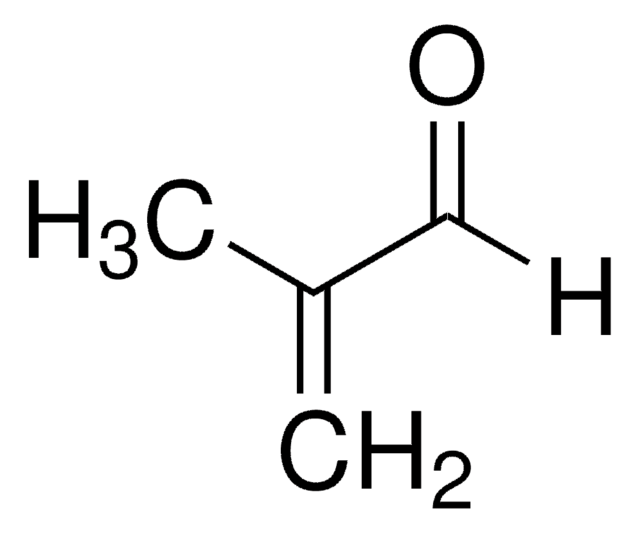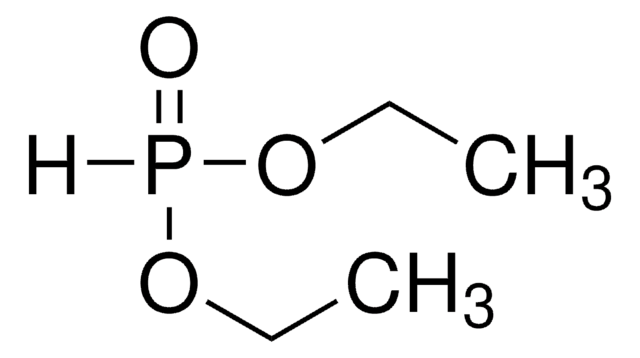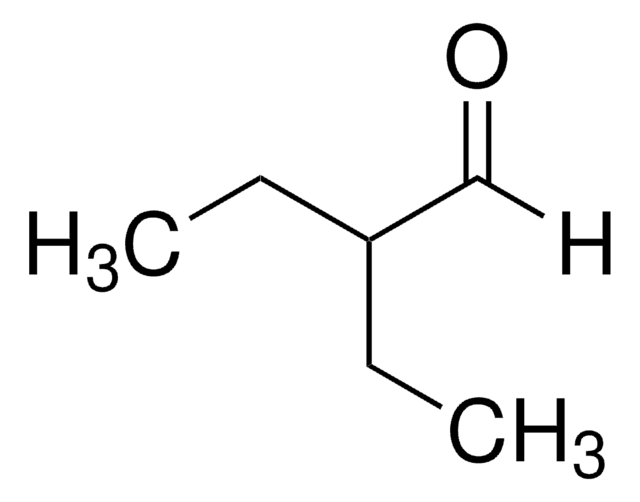262668
Crotonaldehyde, predominantly trans
≥99%, contains 0.1-0.2% BHT as stabilizer, 1% H2O as stabilizer
Sinonimo/i:
(2E)-2-Butenal, (E)-But-2-en-1-al, 2(E)-Butenal, trans-2-Buten-1-al, trans-2-Butenal, trans-Crotonal
About This Item
Prodotti consigliati
Densità del vapore
2.41 (vs air)
Livello qualitativo
Tensione di vapore
32 mmHg ( 20 °C)
Saggio
≥99%
Forma fisica
liquid
Temp. autoaccensione
320 °F
contiene
0.1-0.2% BHT as stabilizer
1% H2O as stabilizer
Limite di esplosione
19.5 %
Indice di rifrazione
n20/D 1.4362 (lit.)
P. eboll.
104 °C (lit.)
Punto di fusione
−76 °C (lit.)
Solubilità
water: soluble 425.4 g/L at 20 °C
Densità
0.846 g/mL at 25 °C (lit.)
Temperatura di conservazione
2-8°C
Stringa SMILE
[H]\C(C)=C(\[H])C([H])=O
InChI
1S/C4H6O/c1-2-3-4-5/h2-4H,1H3/b3-2+
MLUCVPSAIODCQM-NSCUHMNNSA-N
Cerchi prodotti simili? Visita Guida al confronto tra prodotti
Categorie correlate
Descrizione generale
Applicazioni
- Crotonaldehyde (Cis and Trans): Discusses the production and properties of crotonaldehyde, including trans isomer, via aldol condensation of acetaldehyde and catalytic methods (Grant & Jenkins, 2015).
- Modeling, simulation and analysis of a process for the production of crotonaldehyde: Analyzes the production of crotonaldehyde, highlighting the stereoisomeric forms, including trans-crotonaldehyde (Scheithauer et al., 2016).
Avvertenze
Danger
Indicazioni di pericolo
Classi di pericolo
Acute Tox. 1 Inhalation - Acute Tox. 3 Dermal - Acute Tox. 3 Oral - Aquatic Acute 1 - Eye Dam. 1 - Flam. Liq. 2 - Muta. 2 - Skin Irrit. 2 - STOT RE 2 - STOT SE 3
Organi bersaglio
Respiratory system
Codice della classe di stoccaggio
3 - Flammable liquids
Classe di pericolosità dell'acqua (WGK)
WGK 3
Punto d’infiammabilità (°F)
48.2 °F - closed cup
Punto d’infiammabilità (°C)
9 °C - closed cup
Dispositivi di protezione individuale
Eyeshields, Faceshields, Gloves, type ABEK (EN14387) respirator filter
Scegli una delle versioni più recenti:
Possiedi già questo prodotto?
I documenti relativi ai prodotti acquistati recentemente sono disponibili nell’Archivio dei documenti.
I clienti hanno visto anche
Il team dei nostri ricercatori vanta grande esperienza in tutte le aree della ricerca quali Life Science, scienza dei materiali, sintesi chimica, cromatografia, discipline analitiche, ecc..
Contatta l'Assistenza Tecnica.













